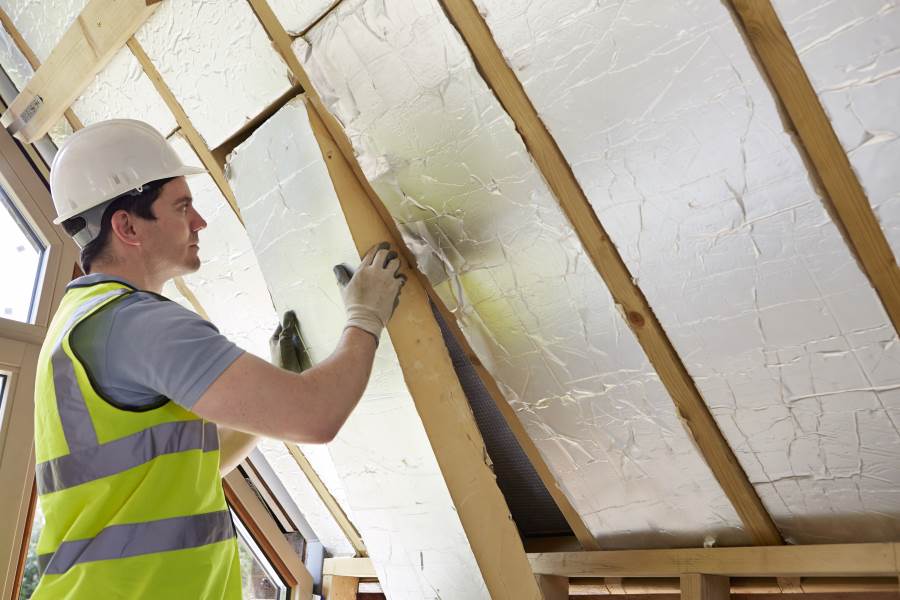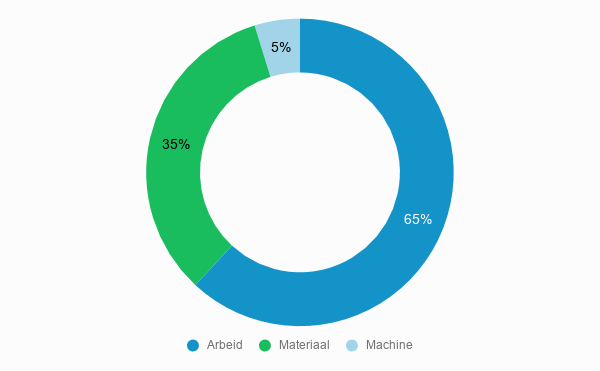Are you interested in the benefits of roof insulation, not only for your wallet, but also because of your living comfort? Then it is useful to find out more about the level of investment as well. Renoca has therefore put together the roof insulation prices and other relevant information for you in a complete overview, so that you can make a well-informed choice.
What does roof insulation cost?
On average, the installation of roof insulation costs £5,000. For this price, the project is carried out by a specialist. So if you go ahead and do it yourself, you will be a bit cheaper. There are various options for insulating a roof, depending on the type of roof you have: a flat or pitched roof. See the table below for an indication of the average prices of insulating a roof per house type.
| House type | Interior sloping roof |
Exterior sloping roof |
Flat roof |
|---|---|---|---|
| Tween house (50 m2) | £3.000 – £3,800 | £3,500 – £4,300 | £2,500 – £3.500 |
| Corner house / semi-detached (65 m2) |
£ 3,900 – £ 4,500 | £ 4,500 – £ 5,500 | £ 3,200 – £ 4,600 |
| Detached house (100 m2) |
£ 6.000 – £7,500 | £7,000 – £8,500 | £5,000 – £7,000 |
Insulating the attic floor
Don’t use the attic and doesn’t need to be heated? Then you can also consider insulating just the attic floor instead of the roof. This only makes sense if the attic has no open connection to the floor below, so that the cold cannot enter the house from the roof.
Find the best specialist for your project and get free quotes.
Start

Price examples
Always check first whether roof insulation is possible and necessary for your house. Houses built after 1980 often already have roof insulation. For these houses, we recommend checking (or having checked) whether this insulation is still sufficient or not so that you can be sure that you are insulating your house to the maximum. We give some price examples for roof insulation based on different situations.
Roof insulation via the outside
Suppose you live in a semi-detached house and have your pitched roof insulated. The choice is insulation via the outside of the roof. You want to keep the beams on the inside of your roof open because of the authentic look they give the room and by insulating them in this way, the roof structure is also protected against cold and damp. You will then have this done for around £4,500 to £5,500 for a 65 m2 roof.
Roof insulation from the inside
Do you live in a terraced house and are you looking for an effective but affordable way to insulate your roof? Then insulating the inside of your roof is a good choice. This is affordable and yields handsome annual savings on energy costs. Besides, your attic is still just suitable as a living space. Roof insulation through the inside of a 50 m2 roof is already possible for around £3,000 to £3,800.
A cheap solution for an unused attic
You do have an attic but it is not actually used as a living space, for example because the attic is not suitable for that. At the moment, the heat still travels to the attic, but it is not actually needed. That’s why you decide not to insulate the roof, but the attic floor. As a result, heat will not reach your sealed attic as easily and so less heat will be lost. If you have the attic floor insulated by a specialist, the costs for 30 m2 of attic floor insulation are around £ 1,000 to £ 1,200, depending on the type of material chosen.
Which insulation material is best for roof insulation?
In general, boards or blankets are used to install roof insulation. You cut these to size so that they provide a perfectly fitting insulating layer.
Each insulation material has its own characteristics which make it more or less suitable for your situation. For example, there are materials such as PIR and PUR with a very high insulation value. So with these insulation materials, a thin layer of insulation is already sufficient. Is environmental friendliness very important to you? Then PIR and PUR are not suitable. Natural materials such as flax, hemp and wood fibre, or mineral wool such as glass wool and rock wool are better choices.
In short, to find out which insulation material is the best choice for you, it is advisable to compare insulation materials on characteristics and compare these characteristics with your needs. A specialist can help you with this and advise you on the right choice of material based on your living situation.
How are roof insulation prices structured?

The prices for installing roof insulation largely depend on three components: labour costs, machine costs and material costs. Machine costs cover only a small part of the total cost. The rest consists of labour and material costs. By requesting quotes and comparing prices from insulation companies, you can save considerably on these.
Subsidy for roof insulation
The government makes subsidies available for private individuals through the ISDE scheme. You can claim this subsidy scheme if you take an energy-saving measure. The subsidy is doubled for two insulation measures. This means that in addition to roof insulation, you either take a second insulation measure or arrange for a heat pump, solar boiler or connection to a heat network. The subsidy amount for roof insulation is £15 per m2 for projects with an implementation date after 2 April 2022. For 2023, the amount remains the same.
The insulation measures are also subject to minimum insulation values. The minimum insulation value for roof insulation is 3.5 Rd. For each insulation material, the thickness you need to reach this value varies. For example, the highly insulating PIR will require a less thick board than, say, glass wool, which also insulates fine, albeit slightly less well.
If you meet these initial conditions, there are still a number of things you need to consider. For example, you may not carry out the insulating measures yourself, you must be the owner of the house, live there and the subsidy must be applied for in time after the first subsidy measure has been carried out. For a complete overview of all conditions, visit the RVO website.
In addition, there are also local subsidy options. You can check whether your municipality, province or water board has subsidies for insulation via the Energiesubsidiewijzer.

Advantages of roof insulation
Why should you (have) your roof insulated? First of all, roof insulation will ultimately save you in costs and provide increased living comfort. After all, the insulation material keeps the cold out in winter and the heat in. It therefore stays warmer in winter and cooler for longer in summer. Your energy bill goes down and the value of the house increases.
In addition to these reasons, insulation material also acts as a sound absorber. So with roof insulation, you will be less bothered by noises from outside. Also not unimportant: insulation material creates a nicely finished attic and helps you create an extra living space.
How is roof insulation installed?
How does installing roof insulation work? The steps vary depending on how you want to insulate the roof. We give a general idea of the work to be carried out using the work of a specialist.
We recommend having roof insulation carried out by a specialist because any moisture in the roof can cause moisture problems, mould and wood rot. A specialist knows exactly how to prevent this and finishes the roof neatly.
Insulating a flat roof
In the case of a flat roof, you have two choices. In the warm-roof method, you first put a vapour control layer on the roof. The layer is secured with single- or double-sided tape, after which the insulation material is laid on your flat roof. Is the roof fully insulated? Then your roof will be neatly finished again, so that you can no longer see the insulation layer.
As opposed to this is the inverted roof method. This involves laying waterproof insulation boards on top of the existing roof covering. A ballast layer often follows on top of the insulation boards for reinforcement and to protect the insulation boards. This method is less labour-intensive than the warm-roof method, but also does not insulate as well.
Insulating the sloping roof from the outside
Do you have a sloping roof insulated from the outside? Then the specialist will first remove the roof covering and the underlying wooden battens from the roof. Is there already insulation material underneath?
The specialist then replaces the old vapour control membrane and lays new insulation material on the roof. This insulation material is cut to size so that the boards fit properly on the roof and lie tightly together to avoid weak spots in your insulation. Therefore, insulation boards are usually used that have a tongue and groove system. This way they fit together perfectly.
The specialist will tape the seams to make the insulation windproof. He will also place a new waterproof foil over the insulation material so that the insulation material is water- and airtight. This prevents draughts or moisture problems and ensures that any moisture in the construction can be ventilated to the outside.
When the insulation material is in place, the wooden battens with the roof covering on top can be neatly put back.
Insulating a pitched roof from the inside
In order to insulate a pitched roof from the inside, first of all the space must be free. Also, the specialist cuts the blankets or sheets to size beforehand. Roof insulation is placed on the inside of the wooden roof truss.
The insulation material is attached to the beams, which ensures an unbroken shield. This gives you optimal insulation. Any gaps and seams are taped so there are no weak spots.
Does everything look good? Then the specialist will finish the inside of the roof, for example with plasterboard. The wall can then be painted or wallpapered immediately.
Find the best specialist for your project and get free quotes.
Start